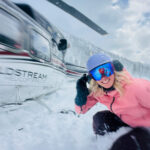There’s no better place than Callaghan Country to learn how to share.
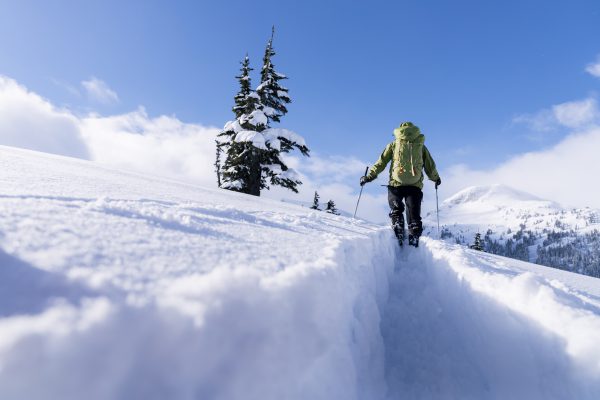
Ski fast. Take chances.” This is Guillaume Otis’s advice at the top of our first run in the Callaghan Valley. It also turns out to be the theme of our four days of ski touring in the backcountry area near Whistler. Among the crew standing beside me, drooling at the untracked canvas of 15 cm of new snow, are an up-and-coming freeride ski competitor and his coach. I don’t know it yet, but things are about to get exciting.
Otis’s advice is not meant as an invitation to get reckless—it’s our best strategy to stay safe. There are small pockets of windslab, the snow is deep and the terrain steep.
“The best way to manage small avalanches and sluffing snow is to ski fast,” he tells us. “Who wants to go first?”
Gavin Phillipson, a coach with the Whistler Freeride Club, doesn’t wait for approval. He lines up a small cliff and flies through the air, a firework tail of snow tracing his arc. After a smooth landing, Phillipson carves super-G turns down the rest of the slope and then sets up to talk his protege, 16-year-old Marcus Goguen, into an even bigger cliff. The rest of us watch as he flies off blindly, stomps the landing and straightlines it to Gavin, bouncing off every little roll and deformity along the way.
This is only our first run, I think, as I take my turn and plunge down the 40-degree slope, faceshots pelting my smile. This is going to be a fun few days of skiing.
I didn’t come to the Callaghan Country expecting a live ski movie, but I did have ulterior motives. First, I wanted to check out its unique business model. It is the most accessible backcountry lodge in B.C., a two-hour drive from Vancouver’s airport to the base area and then an hour or less in a snowcat or on a snowmobile to Journeyman Lodge. And it’s one of the few that caters to both cross-country skiers and backcountry skiers.
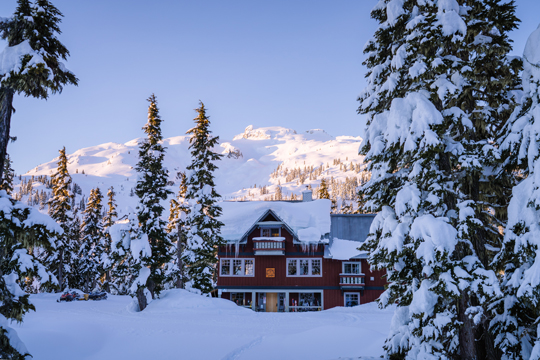
My other, somewhat related, curiosity is how the operation is handling the explosive growth in all things backcountry. Even before the pandemic sent everyone searching for a nature fix, interest in backcountry skiing, snowshoeing, cross-country skiing, snowmobiling and heli-skiing were all growing in the Sea-to-Sky corridor between Squamish and Whistler. Nearby trail counters notched 40 to 100 per cent increase in users. Conflicts between different groups, and sometimes within them, were flaring up. I wondered how all those people were impacting a place that sells solitude and untracked snow.
It was a different world when Brad Sills discovered the Callaghan Valley. Back in the 1970s, Sills was a Whistler ski bum who spent his summers flying around in a helicopter, timber-cruising for forestry companies. He tells me this as we wait to load the snowcat on the first day.
“The Callaghan caught my eye because it’s totally different geography from the rest of the area,” he says.
Where most valleys are V-shaped, the Callaghan is a wide U, a legacy of an ancient volcano that filled in the bottom of the valley. As a cross-country and telemark skier, Sills saw the potential: “perfect” ski touring terrain on the valley sides and “phenomenal” cross-country skiing in between. When he started guiding ski touring in the Callaghan in 1981, he also discovered its microclimate. Surrounded by glaciers and a little closer to the coast, it collects nearly twice as much snow as the same elevation on Whistler or Blackcomb.
A decade later he built Journeyman Lodge, a cozy, three-storey chalet only accessible during the winter. He cut cross-country ski trails around the valley and backcountry skiers began exploring the three drainages within a day trip’s range.
We spend most of our time in the Journeyman zone, the north-facing slope directly across from the lodge. It’s a diverse face with high alpine glaciers, steep couloirs, tree shots and plenty of pillow drops.
Otis focuses on the latter two on the first day.
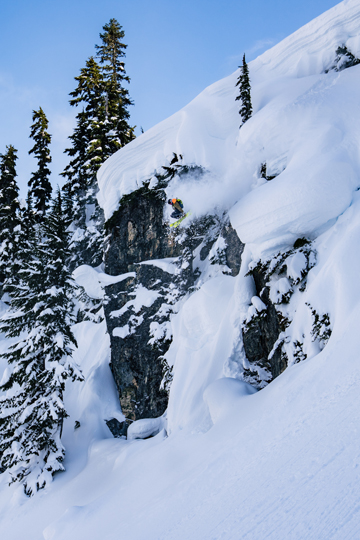
Some people skin or cross-country ski the 10 km from the parking lot to the lodge, but wanting to maximize turning time, we opt for the mechanical lift. With our gear and beer loaded in the cat, we zip up to the lodge. After a quick lunch we head out for that first dose of excitement and then make a long, climbing traverse to Banana Chute.
Again, Goguen stays at the top so Phillipson can talk him into an air. The rest of us ski down into the wide, curving couloir, before pulling up beneath a massive rock face.
Phillipson’s voice crackles through Otis’s radio: “Okay, Marcus, you’re going to drop off a six footer onto a 10-foot-long platform and then it’s the big drop… You’re going to be in the air for a long time.”
With no other feedback, Goguen launches the biggest cliff I’ve ever seen someone ski with my own eyes, without even looking at it first.
Trekking back to the lodge, everyone buzzing from Goguen’s feat, the Journeyman zone spreads out before us. Feeding off his courage, we start pointing out where we want to ski. There’s more exciting terrain than at most ski hills.
Developers have proposed ski resorts for the Callaghan. None went anywhere, until the Vancouver Olympic Committee chose the area just north of Sills’s tenure as the venue for the 2010 cross-country skiing and ski jumping events. The development improved the access road. At the same time, backcountry skiing was booming, and it hasn’t slowed down since.
“Thirty years ago there might have been 500 to 1,000 backcountry skiers who would get out in the winter,” figures Sills, who is also a 40-year veteran of Whistler’s search and rescue crew. “Now we’ll see that many in a single day, in a single area of the Sea-to-Sky.”
The numbers fill his lodge for most of the winter. And they create conflicts. It’s not a terrain shortage issue—there’s plenty for everyone. The problem is getting to it, says Sills. The roads in the Sea-to-Sky are in the valleys, and the good terrain and snow is up high. There just aren’t that many spots for the average ski tourer to access the good terrain in a reasonable amount of time.
Increasing the competition are snowmobilers and heli-skiers. A land use planning process divided up the mountains into motorized and non-motorized zones. But it also further diminished the areas where backcountry skiers can go without the drone of engines. And not everyone sticks to his or her designated terrain.
In the Callaghan Valley there are ski tourers who want to use Sills’s groomed trails to access turns, but don’t want to pay for it. Snowmobiles cross into his non-motorized tenure and sometimes even buzz the lodge. As well, he’s surrounded by heli-ski terrain.
“Things get really tight after two weeks of high pressure,” he says, referring to periods of no snow. “The heli-ski guys have farmed everything else. The snowmobiles have hammered their area. Ski tourers want to get into the alpine. It’s like a food chain.”
That’s when a backcountry skier arrives on a summit after hours of work at the same time as a heli-ski group, just as a snowmobiler tracks up the slope below.
“No one is happy,” says Sills. “I’ve seen fist fights between skiers and sledders. It’s crazy. People feel so entitled.”
We get a taste of this on day two when we skin to the top of Journeyman Peak. From the high perch we look down into the next valley and watch two ant-sized snowmobiles scribbling all over the glacier below. Eventually they come over the ridge into our drainage. They don’t cross into the non-motorized zone, but their buzzing feels like a rude injection. I can only imagine how I’d feel if one of them was tracking up the slope we were about to ski.
I feel lucky we’re not even competing with other skiers. Otis has booked the lodge during the week, when it’s normally closed. We have the place to ourselves. The only tracks we cross are our own. At dinner our only company are the cook and server. And that night it dumps 30 cm of fluffy powder.
What follows is one of the deepest days of skiing any of us can remember. It’s nothing but faceshots top to bottom as we farm fall-line tree runs, surfing the stumps and rocks that seem to litter the slope like a natural terrain park playground.
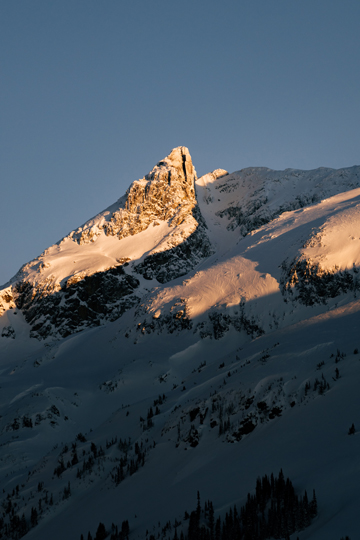
Our last day at Callaghan is a short one. To make the most of it, we get up early, grab packed lunches and hit the skin track, sliding past the sauna, over the creek and up the hill.
Another 10 cm of snow has fallen overnight. Another reset. Our tracks from earlier in the week are gone and we rip four short laps in an area right above the lodge. Like everything we’ve skied it’s super playful. By now I’ve caught Goguen’s bug and am taking to the air as if I’m 16 and fearless. I’m linking drop-to-drop, perfect landing to perfect landing. The gentleman-sized jumps feel gnarly to me…until I watch Goguen hit everything twice as big.
We’ve done a good job of tracking up the most accessible terrain close to the lodge. Thinking about something Sills said to me, I start to feel a little guilty.
“We have to recognize everyone just wants to have fun,” he said. “We all have to play nice in the sandbox.”
These words bounce around my head as I skin toward our final run at Callaghan. There’s no doubt untracked snow is becoming more and more scarce. People seem to be everywhere. For those who have been skiing in the backcountry for a while, it’s hard to accept the change. There’s also no holding it back.
But I also realize a few tracks have never ruined my day. And they never will with my new philosophy on life and skiing. It’s the last thing I hear Otis say as we drop into a party lap right back to the lodge.
“Ski fast. Take chances.”
CLICK FOR POWDER
- Callaghan Country and Journeyman Lodge packages and nightly rates: callaghancountry.com
- Guillaume Otis runs private trips into Journeyman every winter through his company Coast Mountain Guides. coastmountainguides.com
